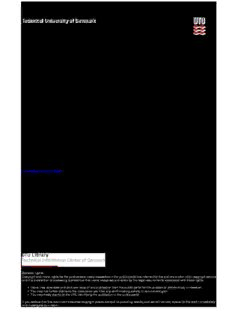Table Of ContentDownloaded from orbit.dtu.dk on: Jan 16, 2023
Eigenbeamforming array systems for sound source localization
Tiana Roig, Elisabet
Publication date:
2014
Document Version
Publisher's PDF, also known as Version of record
Link back to DTU Orbit
Citation (APA):
Tiana Roig, E. (2014). Eigenbeamforming array systems for sound source localization. Technical University of
Denmark, Department of Electrical Engineering.
General rights
Copyright and moral rights for the publications made accessible in the public portal are retained by the authors and/or other copyright
owners and it is a condition of accessing publications that users recognise and abide by the legal requirements associated with these rights.
Users may download and print one copy of any publication from the public portal for the purpose of private study or research.
You may not further distribute the material or use it for any profit-making activity or commercial gain
You may freely distribute the URL identifying the publication in the public portal
If you believe that this document breaches copyright please contact us providing details, and we will remove access to the work immediately
and investigate your claim.
Elisabet Tiana Roig
Eigenbeamforming array
systems for sound source
localization
PhD thesis, November 2014
Eigenbeamforming array systems
for sound source localization
PhD thesis by
Elisabet Tiana Roig
Technical University of Denmark
2014
This thesis was submitted to the Technical University of Denmark (DTU) as partial
fulfillment of the requirements for the degree of Doctor of Philosophy (PhD) in Elec-
tronics and Communication. The work presented in this thesis was completed between
October 1, 2010 and August 1, 2014 at Acoustic Technology, Department of Electrical
Engineering, DTU, under the supervision of Associate Professor Finn Jacobsen, until
June of 2013, and Associate Professors Cheol-Ho Jeong and Finn T. Agerkvist, from
March of 2013 to the end. The project was funded by the Department of Electrical
Engineering at DTU.
Cover illustration: Circular microphone array mounted on
a rigid sphere, by Elisabet Tiana-Roig
Department of Electrical Engineering
Technical University of Denmark
DK-2800 KONGENS LYNGBY, Denmark
Printed in Denmark by Rosendahls - Schultz Grafisk a/s
(cid:2)c 2014 Elisabet Tiana Roig
No part of this publication may be reproduced or transmitted in any form or by any
means, electronic or mechanical, including photocopy, recording, or any information
storage and retrieval system, without permission in writing from the author.
In memory of Finn Jacobsen.
I al Toni, el meu far,
i al Quim, la meva llum.
Abstract
Microphone array technology has been widely used for the localization of sound
sources. Inparticular,beamformingisawell-establishedsignalprocessingmethodthat
mapsthepositionofacousticsourcesbysteeringthearraytransducerstowarddifferent
directions electronically.
The present PhD study aims at enhancing the performance of uniform circular ar-
rays,andtoalesserextent,sphericalarrays,fortwo-andthree-dimensionallocalization
problems, respectively. These array geometries allow to perform eigenbeamforming,
beamforming based on the decomposition of the sound field in a series of orthogonal
functions. In this work, eigenbeamforming is particularly developed to improve the
performance of circular arrays at low frequencies. Compared to conventional delay-
and-sum beamforming, the proposed technique, named circular harmonics beamform-
ing, provides a better resolution at the expense of being more vulnerable to noise. A
simple way to further improve the array performance is to flush-mount the transducers
on a rigid scatterer. For a circular array, an ideal solution is a rigid cylindrical scat-
terer of infinite length. Due to its impracticality, the use of a rigid spherical scatterer is
recommended instead.
A better visualization in the entire frequency range can be achieved with deconvo-
lutionmethods,astheyallowtherecoveryofthesoundsourcedistributionfromagiven
beamformed map. Three efficient methods based on spectral procedures, originally
conceived for planar-sparse arrays, are adapted to circular arrays. They rely on the fact
thatuniformcirculararrayspresentanazimuthalresponsethatisratherindependenton
the focusing direction.
Finally, a method based on the combination of beamforming and acoustic holog-
raphy is introduced for both circular and spherical arrays. This new approach, also
expressible in terms of eigenbeamforming, extends thefrequency range of operation of
conventional delay-and-sum beamforming toward the low frequencies.
Keywords: uniformcirculararrays,sphericalarrays,circularharmonicsbeamforming,
deconvolution methods, spherical harmonics beamforming, holographic virtual arrays
v
Resume´
Mikrofon-array-teknologiharværetmegetanvendttillokaliseringaflydkilder. Navnlig
beamforming er en veletableret signalbehandlingsmetode, som kortlægger placeringen
af akustiske kilder ved elektronisk at styre array transducere mod forskellige retninger.
Dette Ph.d.-projekt stræber efter at forbedre præstationen af ensartede cirkulære
array-systemer, og i mindre grad sfæriske arrays, for hhv. to- og tredimensionale
lokaliseringsproblemer. Disse array-geometrier giver mulighed for at udføre eigen-
beamforming, dvs. beamforming baseret pa˚ dekompositionen af lydfeltet i en række
ortogonale funktioner. I dette arbejde er eigenbeamforming specielt udviklet for at
forbedrepræstationenafcirkulærearraysvedlavefrekvenser. Sammenlignetmedkon-
ventionel delay-and-sum beamforming giver den foresla˚ede teknik, kaldet circular har-
monics beamformning, en bedre opløsning pa˚ bekostning af at være mere sa˚rbar over
for støj. En enkel ma˚de til yderligere at forbedre array-præstationen er at placering
mikrofonerne pa˚ overfladen af en ha˚rd scatterer. For et cirkulært array er en ideel
løsning en ha˚rd cylindrisk scatterer af uendelig længde. Pa˚ grund af vanskeligheder
ved implementeringen anbefales en ha˚rd sfærisk scatterer i stedet for.
En bedre visualisering i hele frekvensomra˚det kan opna˚s med deconvolution-
metoder, da de tillader gendannelse af lydkilders distribution fra et givet beamformed
kort. Treeffektivemetoder,baseretpa˚ spektraleprocedurer,deroprindeligterudtænkt
til plane, sparse arrays, er tilpasset cirkulære arrays. De er afhængige af det faktum,
at ensartede cirkulære arrays viser et azimut respons, der er temmelig uafhængig af
fokuseringen retning.
Endelig indføres en metode, der bygger pa˚ en kombination af beamforming og
akustisk holografi, for ba˚de cirkulære og sfæriske arrays. Denne nye fremgangsma˚de,
somogsa˚ kanudtrykkesiformafeigenbeamforming,udviderfrekvensomra˚detforbru-
gen af konventionel delay-and-sum beamforming mod de lave frekvenser.
Nøgleord: ensartede cirkulære arrays, sfæriske arrays, circular harmonics beamform-
ing, spherical harmonics beamforming, deconvolution-metoder, holografiske virtuelle
arrays
vii
Description:Keywords: uniform circular arrays, spherical arrays, circular harmonics beamforming, deconvolution methods ventionel delay-and-sum beamforming giver den foreslåede teknik, kaldet circular har- your guidance on the dissertation, and your faith in me, this would have simply been impossible.

